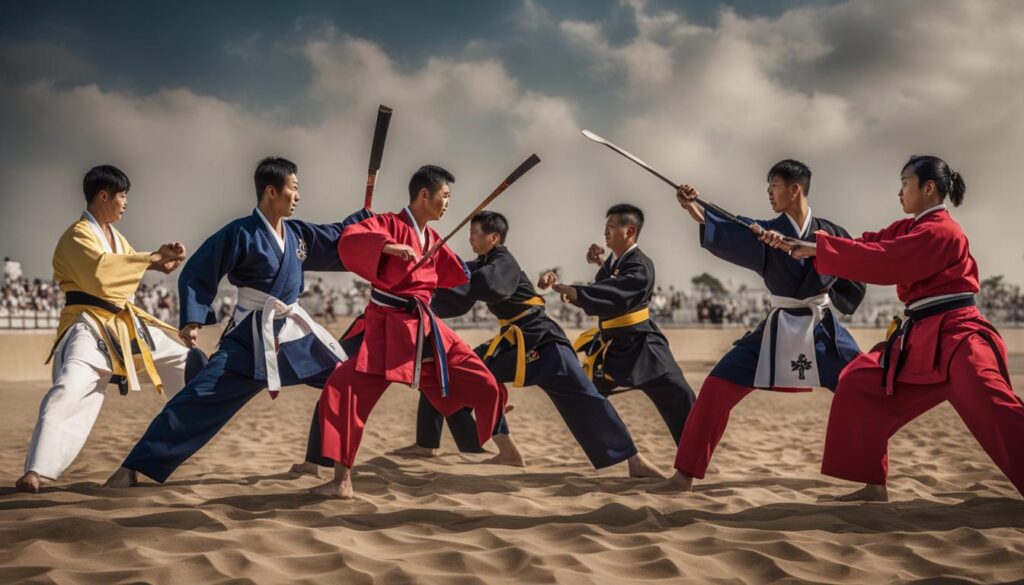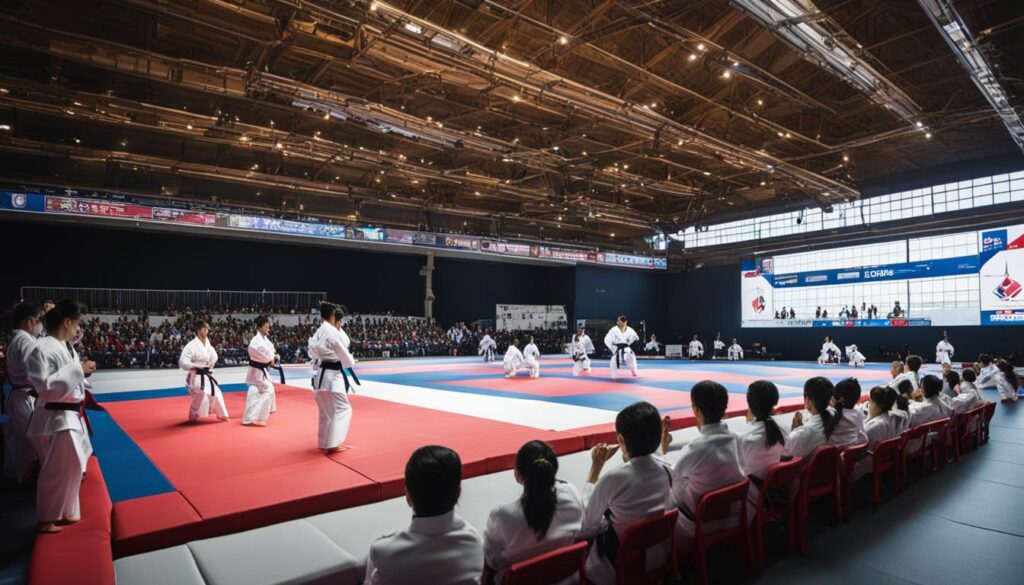Poomsae is an essential component of Taekwondo training, playing a vital role in refining techniques and movements. Taekwondo forms, also known as poomsae, are a sequence of techniques linked together into a pattern of moves. These patterns encompass a wide range of techniques found in Taekwondo and are designed to simulate real-life self-defense scenarios. Poomsae is not only used for training purposes but also for grading students’ progression through the ranks of Taekwondo.
There are a total of 8 Taekwondo patterns, known as the Taegeuks, used to evaluate students’ journey to Black Belt. Additionally, each Black Belt level Dan Grade requires the mastery of specific individual patterns. Through the practice of poomsae, Taekwondo practitioners refine their skills and demonstrate their growth and proficiency in the art.
Key Takeaways:
- Poomsae is a sequence of techniques used for training and grading in Taekwondo.
- Taekwondo forms contain a variety of techniques that simulate real-life self-defense scenarios.
- There are 8 Taekwondo patterns used for grading, known as the Taegeuks.
- Individual patterns are required for each Black Belt level Dan Grade.
- Poomsae helps refine skills and demonstrate growth and proficiency in Taekwondo.
Taekwondo Poomsae Techniques
Taekwondo poomsae incorporate a variety of techniques, including blocks, strikes, and kicks. Each step in the pattern is performed with precision and power, mirroring real-life self-defense scenarios. The techniques in poomsae are designed to develop strength, flexibility, and coordination. The movements in the forms have specific meanings and symbolism, reflecting the principles and philosophies of Taekwondo.
The Importance of Technique
Techniques play a crucial role in the execution of poomsae. Each move is carefully choreographed to showcase a particular skill or aspect of Taekwondo. Blocks are used to deflect or intercept incoming attacks, strikes are used to generate power and create openings, and kicks are employed for both offensive and defensive purposes.
By practicing the techniques in poomsae, practitioners develop not only physical strength but also mental focus and discipline. The precision required in executing each technique promotes concentration and attention to detail.
Meaning and Symbolism
Every movement in Taekwondo poomsae has a specific meaning and symbolism. These meanings are derived from ancient Korean culture, philosophy, and historical events. The movements may represent concepts such as balance, harmony, or the overcoming of challenges.
Understanding the meaning behind each movement enables practitioners to connect with the deeper essence of Taekwondo and develop a more profound appreciation for the art form.
Variety and Complexity
Taekwondo poomsae encompass a wide range of techniques that increase in complexity as practitioners advance through the ranks. Beginners start with fundamental techniques and gradually progress to more advanced and intricate movements.
Learning the different poomsae forms allows practitioners to develop a diverse skill set and expand their understanding of Taekwondo as a whole.
Key Techniques in Taekwondo Poomsae
| Technique | Description |
|---|---|
| Block | Defensive movement to intercept or divert incoming attacks. |
| Strike | Offensive movement to deliver powerful blows to opponents. |
| Kick | Movement involving the use of the legs for both offense and defense. |
| Stance | Position of the body and feet that provides stability and balance. |
| Turn | Rotation of the body to change direction during the form. |
“The techniques in poomsae are not just physical movements; they are a representation of the principles, philosophies, and history of Taekwondo.”
History and Origins of Poomsae
Poomsae, a fundamental aspect of Taekwondo, has a rich history that dates back over 5,000 years to ancient Korea. Throughout the centuries, it has evolved and been passed down through generations, preserving the essence of far-eastern philosophy and practical experiences. The patterns and movements of poomsae reflect the traditional teachings and principles of Taekwondo, providing a window into the martial arts practices of the past.
One significant aspect of poomsae is its close association with the ranking system in Taekwondo. Different levels of poomsae are linked to specific ranks and Dan grades, allowing practitioners to showcase their progress and skill. As students advance in their Taekwondo training, they learn and perform increasingly complex poomsae, symbolizing their growth and mastery of the art.

Benefits of Poomsae in Taekwondo
Taekwondo poomsae training offers a wide range of benefits for practitioners. Whether you are a beginner or an advanced student, incorporating poomsae into your training can have a positive impact on your physical, mental, and emotional well-being.
Improved Focus, Discipline, and Concentration
One of the key benefits of poomsae training is its ability to enhance focus, discipline, and concentration. As practitioners perform the precise and intricate movements of each pattern, they learn to maintain a high level of concentration and mental focus. This helps cultivate discipline and attention to detail, which are essential qualities in the practice of Taekwondo.
Enhanced Physical Fitness, Strength, and Flexibility
Poomsae training in Taekwondo is a rigorous physical activity that contributes to overall fitness. The patterns involve a combination of strikes, kicks, and blocks, which help improve strength, flexibility, and coordination. Regular practice of poomsae can lead to increased cardiovascular endurance, muscular strength, and enhanced range of motion.
Moving Meditation for Mental Clarity and Stress Relief
Poomsae training is not just a physical exercise; it is also a form of moving meditation. As practitioners focus on their breath and the precise execution of each movement, they enter a state of mindfulness and mental clarity. This practice helps reduce stress, alleviate anxiety, and promote a sense of calmness and well-being.
Self-Control, Perseverance, and Goal Setting
In addition to the physical and mental benefits, poomsae training in Taekwondo instills important life skills such as self-control, perseverance, and goal setting. As practitioners progress through the patterns and strive to perfect their techniques, they learn the value of discipline, patience, and persistence. Poomsae training encourages practitioners to set goals and work towards achieving them, fostering a sense of personal growth and accomplishment.
Improved Overall Well-being and Self-confidence
The holistic nature of poomsae training makes it a powerful tool for improving overall well-being. The physical exercise, mental focus, and personal development fostered through poomsae contribute to increased self-confidence and self-esteem. Regular practice of poomsae empowers practitioners, both on and off the mat, enabling them to face challenges with a sense of resilience and confidence.
In this section, we have explored the various benefits of poomsae training in Taekwondo. From improved focus and discipline to enhanced physical fitness and self-confidence, poomsae offers a comprehensive approach to personal growth and development. Whether you are training for self-improvement or considering competitive participation, the practice of poomsae will undoubtedly enrich your journey in Taekwondo.
Poomsae Competitions in Taekwondo
Poomsae competitions are a thrilling and highly anticipated aspect of Taekwondo. These competitions provide a platform for participants to showcase their skills, precision, and artistry in performing the intricate patterns of poomsae. It is a true test of a practitioner’s technique, control, and ability to execute each movement with fluidity and grace.
Competitions are carefully structured to ensure fair and balanced competition. Participants are divided into different age groups and skill levels, allowing them to compete against others at similar stages of their Taekwondo journey. This ensures that each participant is judged on their own merits and proficiency.
Judges, highly trained and experienced in Taekwondo, play a crucial role in poomsae competitions. They meticulously assess each performance based on established criteria such as execution, accuracy, and performance quality. Their expertise and discernment guarantee that only the most deserving participants receive recognition and rewards.
Participating in poomsae competitions not only allows practitioners to challenge themselves but also serves as a valuable learning experience. Competing against other skilled individuals provides an opportunity for personal growth, motivation, and inspiration. It pushes practitioners to continuously improve their techniques and master the art of Taekwondo poomsae.
Furthermore, poomsae competitions serve as a platform for practitioners to gain recognition and establish their reputation within the Taekwondo community. Not only do successful performances elevate their standing among their peers, but they also become sources of inspiration for aspiring practitioners, motivating them to strive for excellence.
Participating in poomsae competitions also encourages practitioners to further refine their techniques. The feedback received from judges, fellow competitors, and coaches helps identify areas for improvement and growth. It allows practitioners to fine-tune their skills and develop a deeper understanding of the intricacies of each poomsae pattern.

Conclusion
Poomsae is not just a sequence of moves in Taekwondo; it is a profound journey of self-discovery and personal growth. By regularly practicing poomsae, Taekwondo practitioners can experience a multitude of physical, mental, and emotional benefits.
The art of poomsae is deeply rooted in the rich history and philosophies of Taekwondo. It allows practitioners to connect with the ancient traditions and principles that have shaped this martial art for over 5,000 years.
Through the intricate patterns and precise techniques of poomsae, practitioners can improve their skills, discipline, and overall well-being. It offers a holistic approach to training, promoting physical fitness, mental focus, and emotional balance. Whether one’s goal is personal development or competitive achievements, poomsae plays an essential role in the journey of a Taekwondo practitioner.
FAQ
What is poomsae in Taekwondo?
Poomsae is a sequence of Taekwondo techniques linked together into a pattern of moves. It is used for basic training purposes in Taekwondo to refine techniques and movements.
How are poomsae used in Taekwondo?
Poomsae is used for grading students’ progression through the ranks of Taekwondo. It is also performed in competitions to showcase skills and precision.
What techniques are included in poomsae?
Taekwondo poomsae incorporate a variety of techniques, including blocks, strikes, and kicks. Each step in the pattern is performed with precision and power.
What is the history of poomsae in Taekwondo?
Poomsae has a long history that spans over 5,000 years. It originated in ancient Korea and has evolved over time, incorporating elements of ancient far-eastern philosophy and practical experiences.
What are the benefits of poomsae training in Taekwondo?
Poomsae training helps improve focus, discipline, and concentration. It also enhances physical fitness, strength, and flexibility. It promotes mental clarity and stress relief, teaches self-control and perseverance, and improves overall well-being and self-confidence.
What are poomsae competitions in Taekwondo?
Poomsae competitions are a popular aspect of Taekwondo where participants showcase their skills and precision in performing the patterns. Judges evaluate the execution, accuracy, and performance quality of the competitors.
